Mathura Peda is a very delightful, rich and classic mithai (sweet dish) prepared with mawa (milk solids), milk, sugar, ghee and scented with cardamom.
One of the beauties of Mathura Peda is its simplicity. With just four basic ingredients, you can craft a sweet masterpiece that is a part of traditions.
Incorporate native spices, herbs, and grains for a taste of your region's culinary heritage.
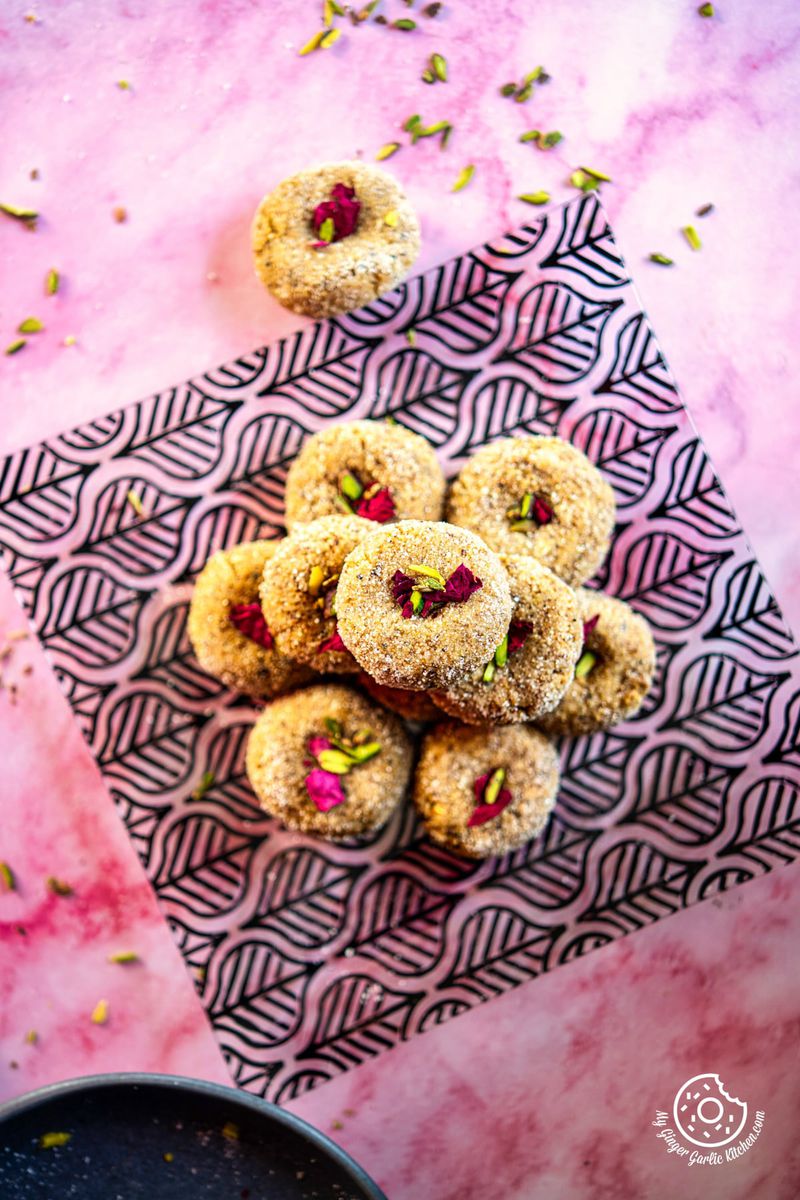
Table of contents
This authentic Mathura Peda recipe has the essence of Mathura which is a city from the Indian state of Uttar Pradesh. Mathura is a city that is famous for its delectable sweets and spirituality.
On this page, you will get a step-by-step picture recipe and a video guide on How to Make Mathura Peda Recipe. With this fail-proof recipe you will get the perfect texture and flavor every time.
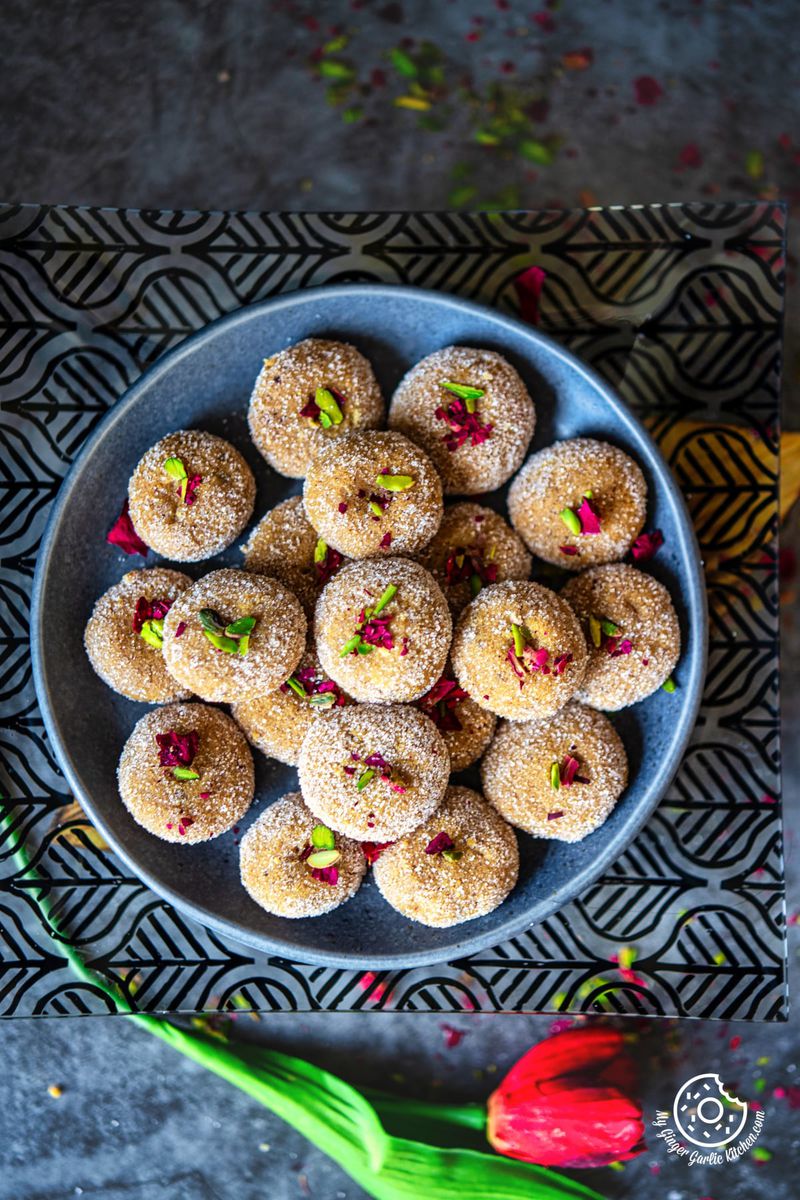
About Mathura Peda
This delicacy Mathura Peda is a heavenly treat, and the allure of Mathura ka Peda is irreplaceable. As the name suggests, Mathura Peda originated in Mathura which is also known as the birthplace of Lord Krishna.
This place, also known as Braj Bhoomi, is as renowned for its delicacies as for its temples.
A trip to Mathura is incomplete without pampering in the timeless exquisiteness of mawa (khoya) Peda, which is an essential part of this city’s enriching legacy. Made with mawa, milk, sugar, and cardamom, these golden-brown Pedas from Mathura are heartwarming sweetness.
More than just a sweet; Peda is an integral part of culture and tradition and that’s why Peda is an essential treat during religious festivals and ceremonies.
During pujas or other religious ceremonies, Peda is often offered as prasad to deities and then distributed among devotees as a blessed delight. Mathura Ke Pede is also a token of devotion and emotion and that’s why it is offered as a “Prasad” at many temples.
A unique golden-brown tint of these Mathura Ke Pede comes from simmering the whole milk or Mawa on low heat. So, this mithai ‘Peda’ is a labor of patience, devotion, and love, and all the demanding stirring is worth it when you get the unmatched flavor and texture of peda.
Peda is also a nostalgic emotion for many adults as it was their favorite childhood treat. If I recall my childhood, it would have been bland without these traditional and delightful Indian milk-fudge pedas. So peda is one such dessert which is loved by adults and kids alike.
Whether you are celebrating Janmashtami (Lord Krishna’s Birthday), or just want to indulge in the world’s tastiest milk peda, the divine flavors of Mathura Peda will take you to the heart of Mathura.
With this easy recipe you can recreate the delicious Mathura Peda in your own kitchen.
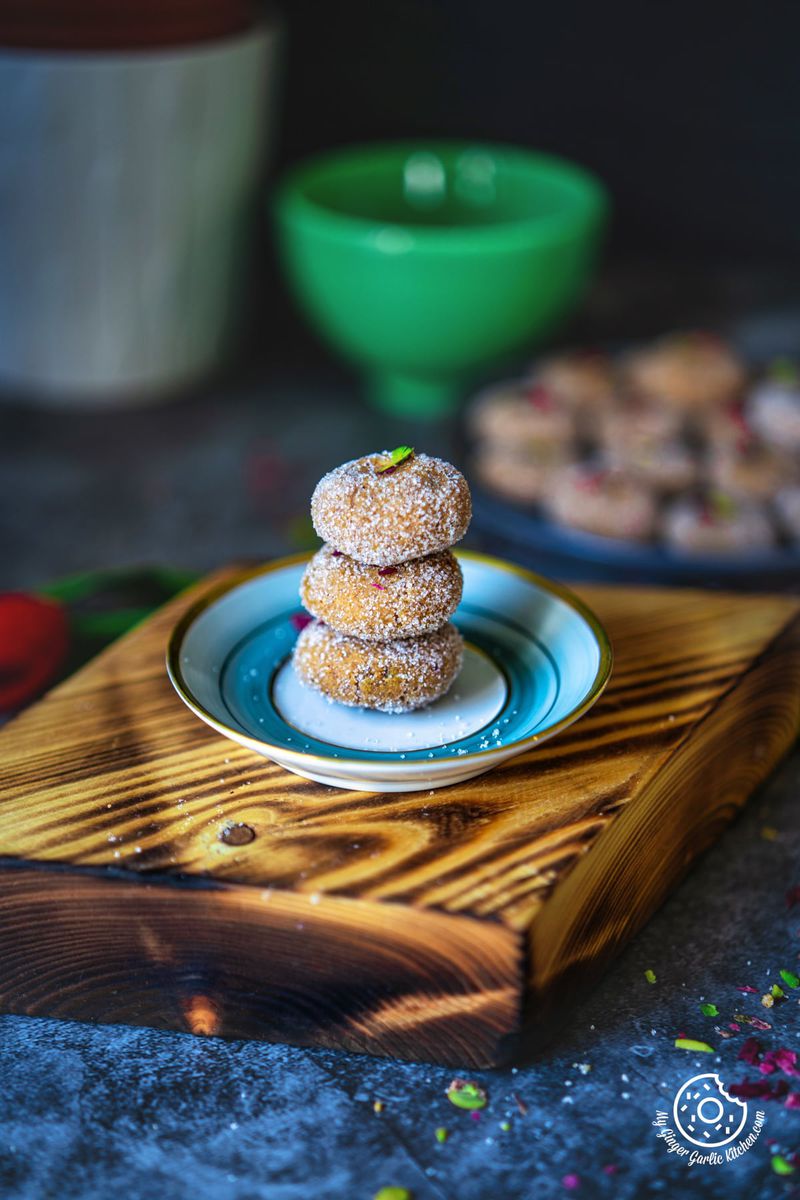
This Mathura Peda
✔︎ has authentic flavors
✔︎ has melt-in-your-mouth texture
✔︎ is delightful, smooth and creamy
✔︎ has a lovely caramel color
✔︎ is a must during Janmashtami celebration
✔︎ is made with just 4 ingredients
✔︎ can be made by beginners and experienced cooks
✔︎ is easy and simple to make
✔︎ is hard to resist
✔︎ is also offered as prasad
✔︎ is also suitable for gift boxes
Ingredients
-
Grated Mawa (Khoya): Milk solids or Mawa (also known as khoya) is the main ingredient of Mathura Peda. Prepared by simmering milk until the moisture evaporates, leaves behind the solid milk solids. This creamy ingredient is used as a rich, creamy base for Mathura Peda which gives it its distinct velvety texture and authentic flavor. If you don’t have mawa, then you can make your own mawa. To make mawa, use a mixture of 2.5 cups of milk powder and 1/2 cup milk. Sauté this mixture until it is solid and your mawa is ready.
-
Ghee: Ghee, also known as clarified butter, is used to roast mawa. It increases the richness and flavor of the pedas and adds a delicate nutty aroma. It gives a smooth and luscious texture and prevents it from sticking to the bottom of the pan.
-
Milk: You will need some whole milk to reach the perfect consistency, creaminess and melt-in-the-mouth texture in Mathura Peda. It also plays a crucial role in binding the ingredients together.
-
Granulated Sugar/Tagar/Bura: Sugar is the main ingredient to sweeten the peda. It is also used to coat the pedas to create a sweet, slightly crystalline exterior. The sugar coating adds a delightful crunch to each bite.
Traditionally, tagar/bura (Indian fine or granulated sugar) is added to peda recipes for their distinct texture and a slight crunch. I have used granulated sugar here, but you can use any of your preferred sweeteners here.
-
Cardamom Powder: It is used to flavor mathura peda. The sweet spice’s delightful fragrance complements the creamy and milky peda. It gives the peda a subtle, warm flavor and its authentic taste.
-
Optional Ingredients: I have garnished the pedas with dried Rose Petals and pistachios to make them look appealing and give them an aesthetic touch. Mathura Peda in the sweet shops is generally sold without garnish, so garnishing it is optional here.
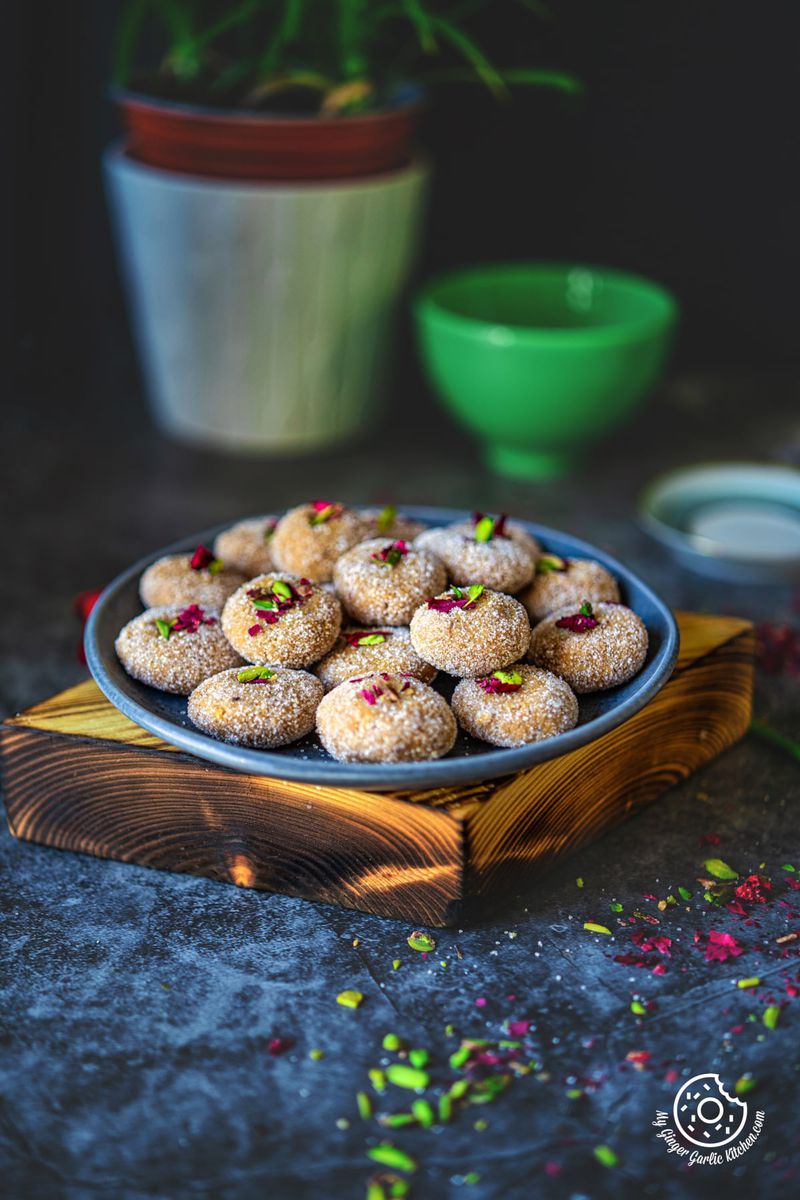
Variations
Nutty Mathura Peda
You can add a handful of chopped nuts to the peda mixture to make Nutty mathura peda. For added crunch and nutty texture, add a mix of chopped nuts (almonds, cashews, and pistachios) to the peda mixture. You can also roll the pedas in powdered chopped nuts for a nutty layer.
Kesar (Saffron) Mathura Peda
For a saffron infused mathura peda version, add saffron soaked milk to the peda mixture. This will give a yellowish color and floral fragrance to the peda.
Coconut Mathura Peda
Love coconut flavored desserts? Then add about 1/2 cup of desiccated coconut or coconut powder to the peda mixture. It will add a delightful coconut-flavor to this peda version.
Dry Fruits Mathura Peda
Love dry fruits in milk-based desserts? Then try incorporating chopped dried fruits like dried apricots, dried cherries, dried figs, raisins, dried dates into the peda mixture. The dried fruits add sweetness and a chewy texture to the peda.
Jaggery Mathura Peda
Want to healthify this peda recipe? Then swap granulated sugar (bura) with powdered jaggery. It adds a rustic touch, caramelized sweetness to this mathura peda recipe. Jaggery goes well with the creamy texture of the milky peda.
Rosewater Mathura Peda
Rose flavor tastes great in Indian desserts. The addition of rose water adds an elegant floral aroma and flavor to this mathura peda.
Nutella Mathura Peda
If you are a fan of Nutella desserts, then you can try this modern twist. For making this version, simply add 2 tablespoons of Nutella to the peda mixture, or stuff the peda with Nutella.
Stuffed Mathura Peda:
You can take your peda to the next level by stuffing them with a filling of your choice. You can add any dessert filling of your choice to make Stuffed mathura ke peda. Fillings that go well in this peda are:
-
Dates And Nuts
-
Chopped Dry Fruits,
-
Crushed Nuts Mixed with Sugar or Honey
-
Gulkand
-
Nutella
-
Strawberry Jam
-
Small piece of flavored fudge
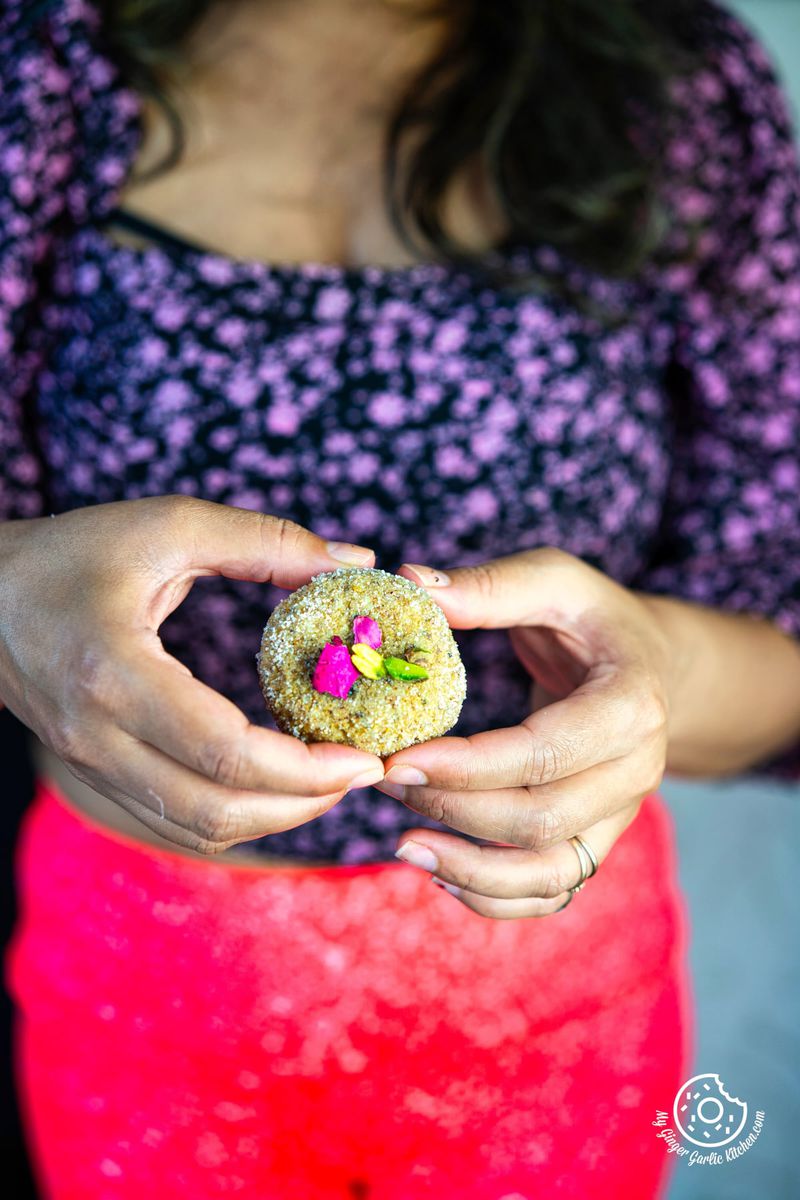
Storage Suggestions
Mathura Ke Pede stays fresh for up to 3-4 days when stored in an airtight container in a cool and dry place. An airtight container prevents the peda from drying out.
If you want to store mathura peda for a long time, then store them in the refrigerator for up to 10 days (about 1 and a half weeks).
Freezing
If you want to enjoy pedas for months, then you can store them in the freezer. To freeze, wrap each peda in a plastic wrap and then transfer them to a freezer safe container or a freezer-safe bag and freeze for up to 2-3 months.
Whenever you want to enjoy, thaw these pedas overnight in the refrigerator or at room temperature for a few hours.
Serving Suggestions
You can serve Mathura peda as it is or decorate it with some dried rose petals, chopped pistachios, like I did. Other than eating it as a Prasad (sacred food) you can accompany Mathura Peda with a cup of masala chai, hot milk or any beverage of your choice.
Dessert Plate: You can also include in a dessert platter for celebrations, they complement other Indian sweets (such as Rose Kaju Katli, Mango Kalakand, Badam Burfi Recipe, Dry Fruits Laddu, Badam Ladoo) and desserts beautifully. Or simply add them to your festive thali during festive occasions and serve them as a traditional dessert to celebrate the occasion with family and guests.
Gifts: These Pedas also make a lovely holiday gift for family and friends during festivals like Holi, Diwali, Janmashtami, Raksha Bandhan, Ganesh Chaturthi, etc.
You can simply individually wrap pedas and then pack them in an attractive gift box or a personalized cookie tin and your sweet box for celebrations or special occasions is ready.
Fusion recipe with Mathura Peda: You can also get creative and make Fusion dessert using this peda. You can add Crushed pedas to Plain lassi to make Peda lassi, add crushed Peda to vanilla Ice cream base to prepare peda ice cream, stuffed parathas to make dessert Peda Partaha, or make a Peda Parfait.
Tips and Tricks to make best Mathura Peda
1.Quality of Mawa (Khoya): Mawa or Khoya is the heart and soul of this dessert, so make sure either you use fresh homemade mawa or use high-quality mawa (khoya) which is fresh and soft. Fresh mawa makes the best tasting creamy and smooth pedas. If for some reason your mawa is hard, then add 1 tablespoon of milk to the crumbled mawa and heat it in a microwave or a stove top pan to soften it before use.
-
Best Pan: For making mawa desserts or other milk-based desserts it is recommended to use a thick bottomed pan or use a non-stick pan as they prevent sticking and burning.
-
Perfect temperature: Always remember to roast the peda mixture over low to medium-low heat for even cooking. A slow cooking process ensures that you achieve the right color, consistency and prevents burning.
-
Storage: To keep their freshness and prevent them from becoming dry, store these pedas in an airtight container or a parchment paper lined mithai box for up to 3-4 days at room temperature.
-
Ghee: It is added for aromatic flavor and to prevent the mixture from sticking. Make sure that you don’t add too much ghee, or the pedas will become greasy.
-
Stirring: Keep stirring the peda mixture continuously on low heat to avoid lumps and ensure even cooking. Also use a spatula or a wooden spoon to press down the hard pieces and to scrape the sides and bottom of the pan.
-
Check the doneness: To check the doneness, take a small portion of the mixture and roll it into a ball, if it holds its shape without sticking to your hands, it’s ready for shaping the pedas.
-
Cooling Time: Pedas will firm up as they cool, so let the pedas cool completely before serving and storing.
-
Flavoring: I have added freshly ground cardamom powder to flavor these pedas. You can also add other dessert flavorings like saffron, cinnamon, rose water or kewra water.
-
Sugar Variations: Traditionally pedas are made with Tagar/bura (Indian style granulated sugar), but you can experiment with diverse types of sugar such as brown sugar, khand, or muscovado sugar to get a unique taste and texture.
-
Shaping and Garnishing: To roll pedas, grease your palms lightly with ghee to prevent sticking. You can serve them with or without garnishing, they taste great both ways.
-
Customize the Size: Pedas are generally bite-sized, but you can shape pedas in any shape or size depending on your serving preference.
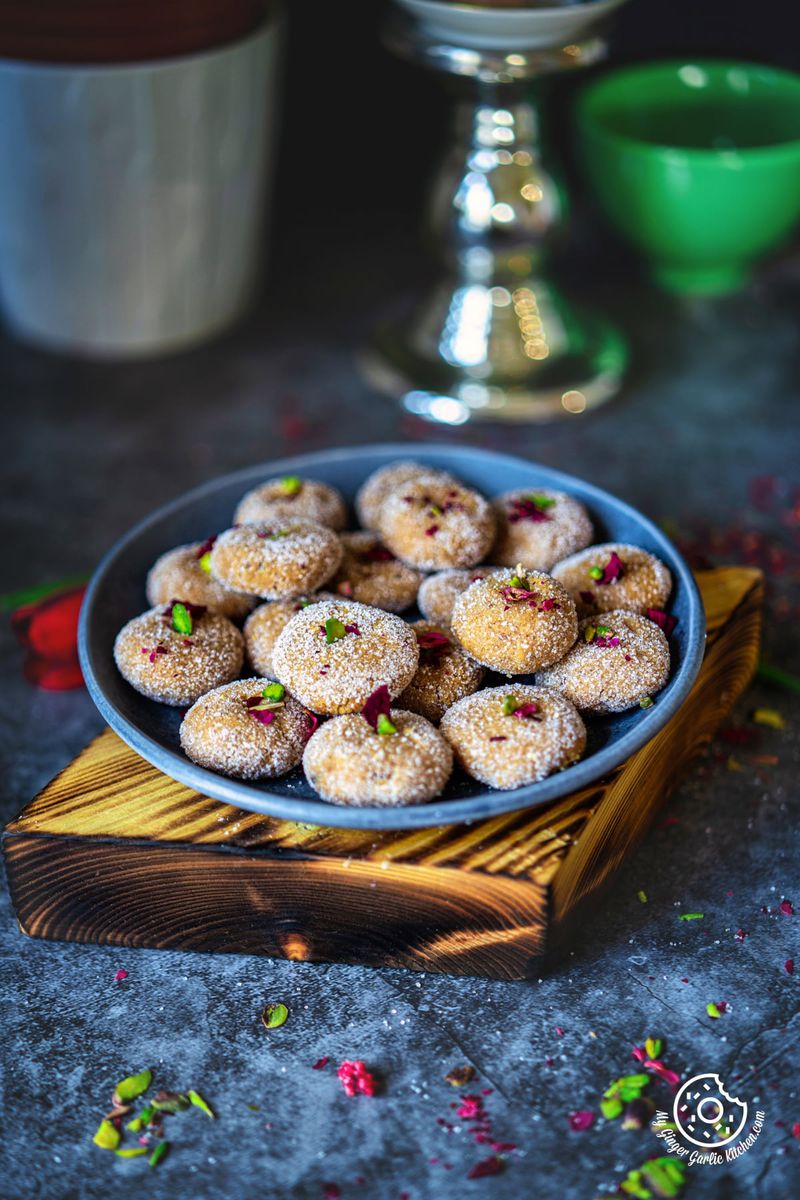
FAQ
Is Mathura Peda gluten-free?
Yes, Mathura Peda is a gluten-free dessert as it doesn’t contain any wheat-based ingredients, so it is safe if you have dietary restrictions. If you are using store bought mawa, then make sure to check the labels of store-bought khoya to guarantee it’s gluten-free.
What is Mathura Peda, and what makes it special?
Mathura Peda is a popular Indian sweet from the city of Mathura. It is a dessert that is renowned for its richness, authentic flavor and creamy texture. The birthplace of Lord Krishna is Mathura, and the peda is associated with Krishna, that’s why it is so special.
Can I use store-bought khoya instead of making it at home?
Yes, store-bought khoya or mawa can be used for making this peda recipe. Just remember to use the mawa that is fresh and of excellent quality.
Can I make Mathura Peda without cardamom powder?
It is a traditional flavoring for making peda. However, if you don’t like cardamom powder then feel free to omit it from the recipe. Alternatively, you can also use other flavoring such as rosewater, saffron, or nutmeg.
How can I make brown pede like the ones in Mathura?
This is a brown peda recipe. To prepare brown pede, you need to cook the peda mixture a bit longer until it develops a deeper caramelized color. To give it a deep brown color and rustic flavor, you can also use jaggery powder instead of sugar.
Can I make Mathura Peda for festivals other than Janmashtami?
Certainly, you can. This Peda is a versatile mithai that can be eaten during all festivals, celebrations, parties, family gatherings, or just as an indulging dessert any time of the year.
What is the shelf life of Mathura Peda, and how should I store it?
These pedas can be stored at room temperature for 3-4 days in an airtight container. For longer shelf life, it is recommended to refrigerate them for up to 2-3 weeks. You can also freeze these pedas for up to 2-3 months.
Can I customize Mathura Peda by adding nuts or flavorings?
Yes, customizing Mathura Ke Pede if possible. You can add your favorite nuts or flavorings of your choice to make different variations of this peda recipe. I have also given peda variations on this page here.
How do I prevent the peda mixture from sticking to the pan while cooking?
Make sure to use a heavy-bottomed pan or a non-stick pan to cook the mixture. Also, continuously stir it over low to medium-low heat to prevent sticking and burning.
Can Mathura Peda be served to children and the elderly?
Yes, Peda is a delight that is suitable for everyone who is healthy and doesn’t have any dietary preferences. The soft texture of this sweet dish makes it easy to eat. In fact, it’s a favorite bite-sized dessert among kids and adults alike.
Mathura Peda (Step-by-step photo instructions)
For making Mathura Peda
- Heat a non-stick pan or a heavy-bottomed pan over medium-low heat. Add the grated mawa (khoya) to the pan and roast it for about 5 minutes. After 5 minutes, add about 1 tablespoon of ghee and mix well to combine. Stir continuously on low heat to prevent the mawa from burning and sticking to the bottom of the pan. Cook for another 3-4 minutes until the mawa starts to turn light golden in color and releases a sweet aroma.
- While stirring, add 1/2 cup of milk gradually to the mawa. Continue to roast on low heat and stir until the milk is absorbed, and the mixture thickens. This should take around 3 minutes. When the milk is absorbed, add the remaining 1/2 tablespoon of ghee and mix again. Keep stirring and roasting the mawa at low heat for 3-4 minutes or until it turns deep caramel brown in color. Once the mixture looks perfectly roasted, turn off the heat. Add 1/2 teaspoon of cardamom powder to the mixture and mix well until combined. Let the mixture cool for a few minutes.
- Transfer this mixture onto a plate and spread it using a spatula. Add sugar/tagar/bura and mix with a spatula. When the mixture is warm but manageable to touch, knead it into a smooth dough using your hands. You can add 1-2 tablespoons of boiled and cooled milk if the mixture seems dry.
- Once the dough is ready, grease your hands with a little ghee and take small portions of the mixture to shape into pedas. Roll each portion into a smooth ball and then flatten it slightly to form a peda shape. Repeat the process until all peda mixture is used. I was able to get 19 small pedas out of this peda mixture. Place the 1/2 cup of sugar in a bowl/plate. Roll each peda in the sugar to coat it evenly. This sugar coating will give the pedas a sweet outer layer and a beautiful texture.
- Garnish each peda with dried rose petals and chopped pistachios for a traditional touch and added flavor. Let the pedas cool completely at room temperature. Once they cool, they will firm up. Your homemade Mathura pedas are ready to be enjoyed. Relish them immediately with friends and family, or store them in an airtight container at room temperature. They should stay fresh for a few days.

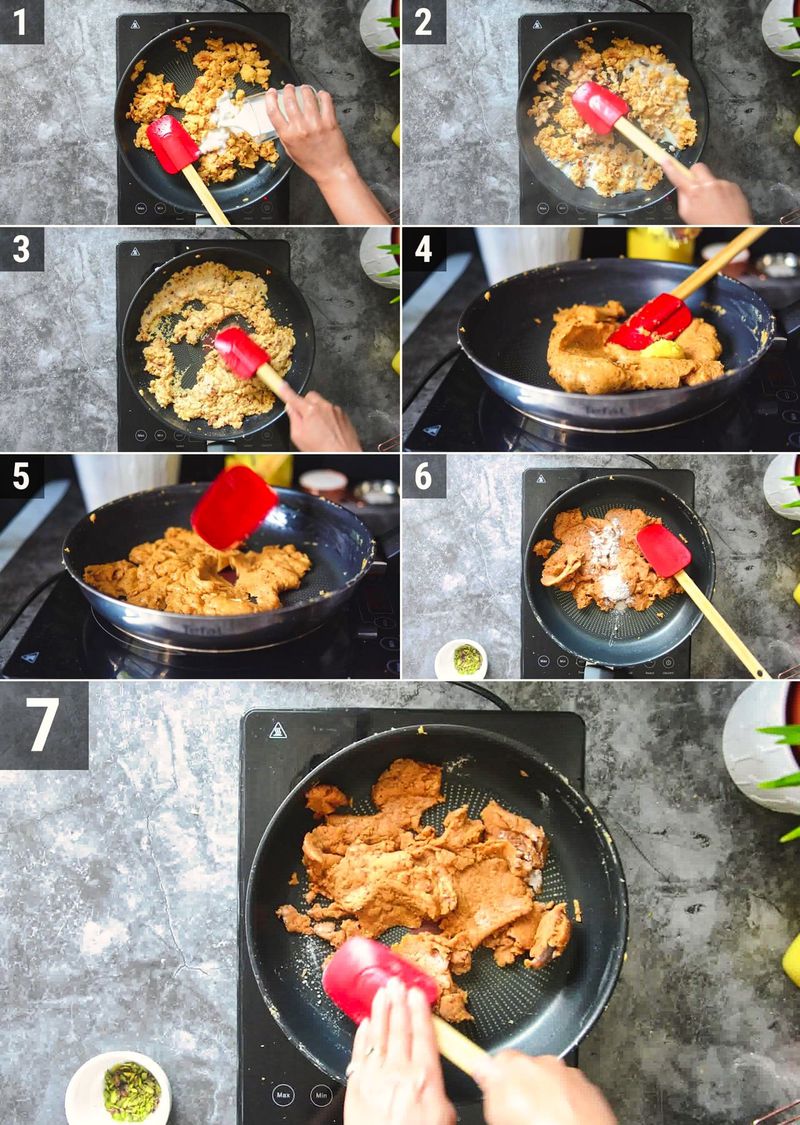
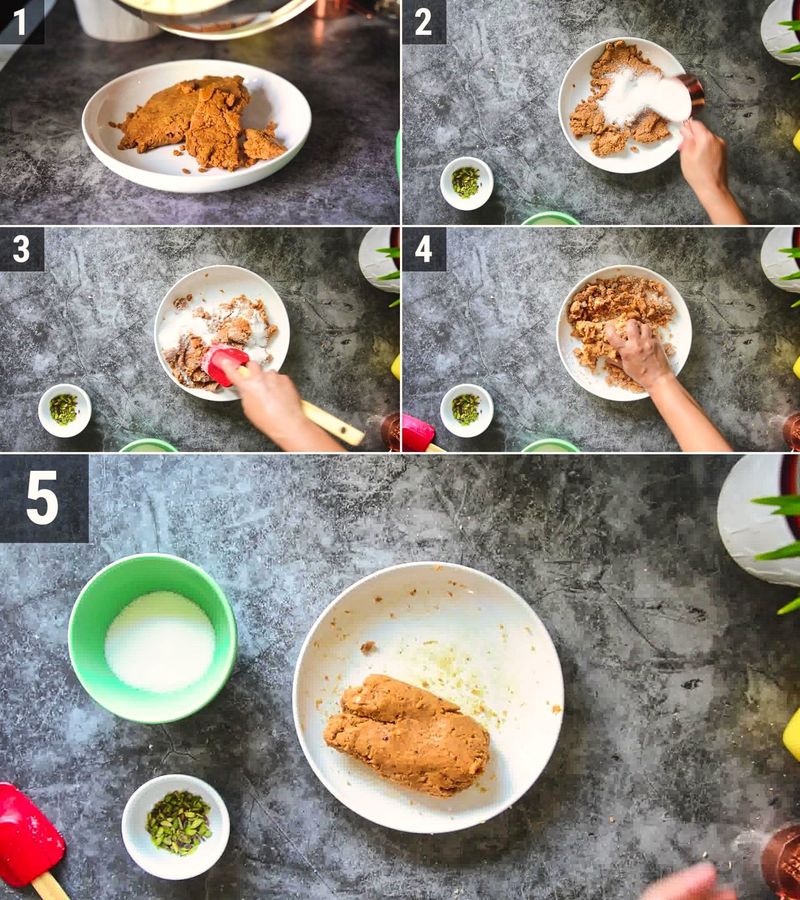
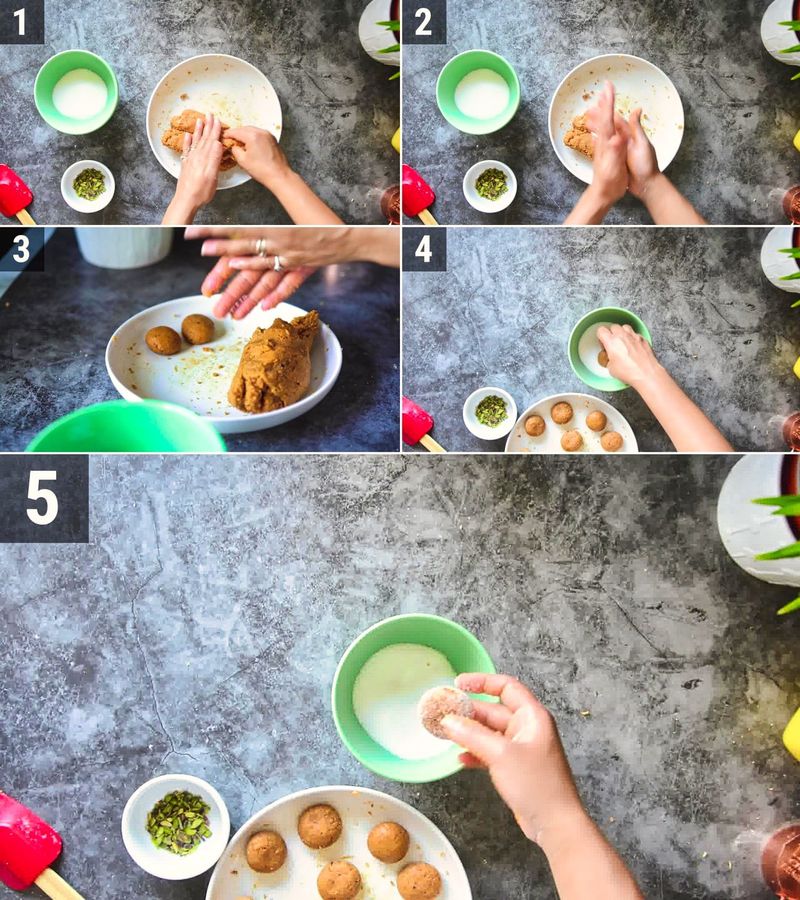
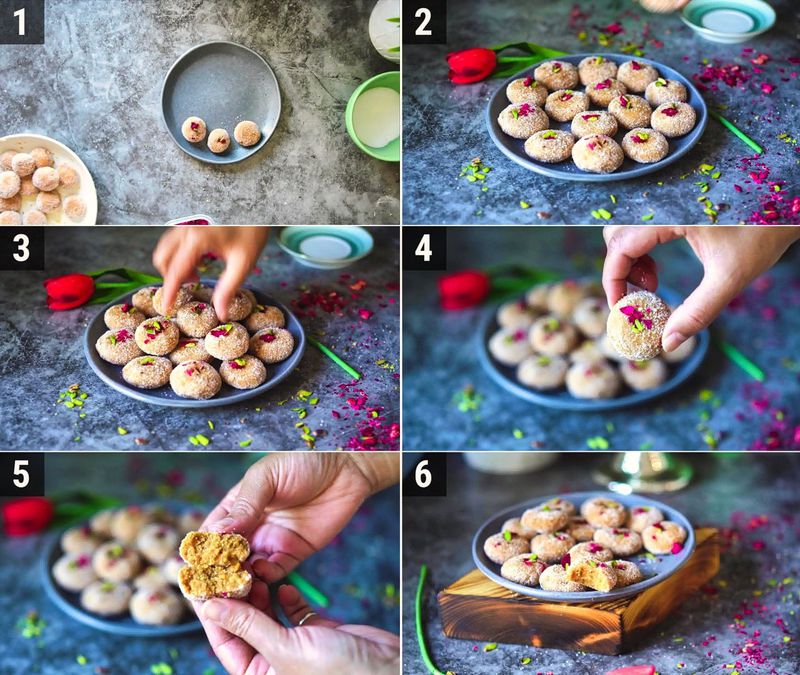
Recipe Card
Mathura Peda [Recipe]
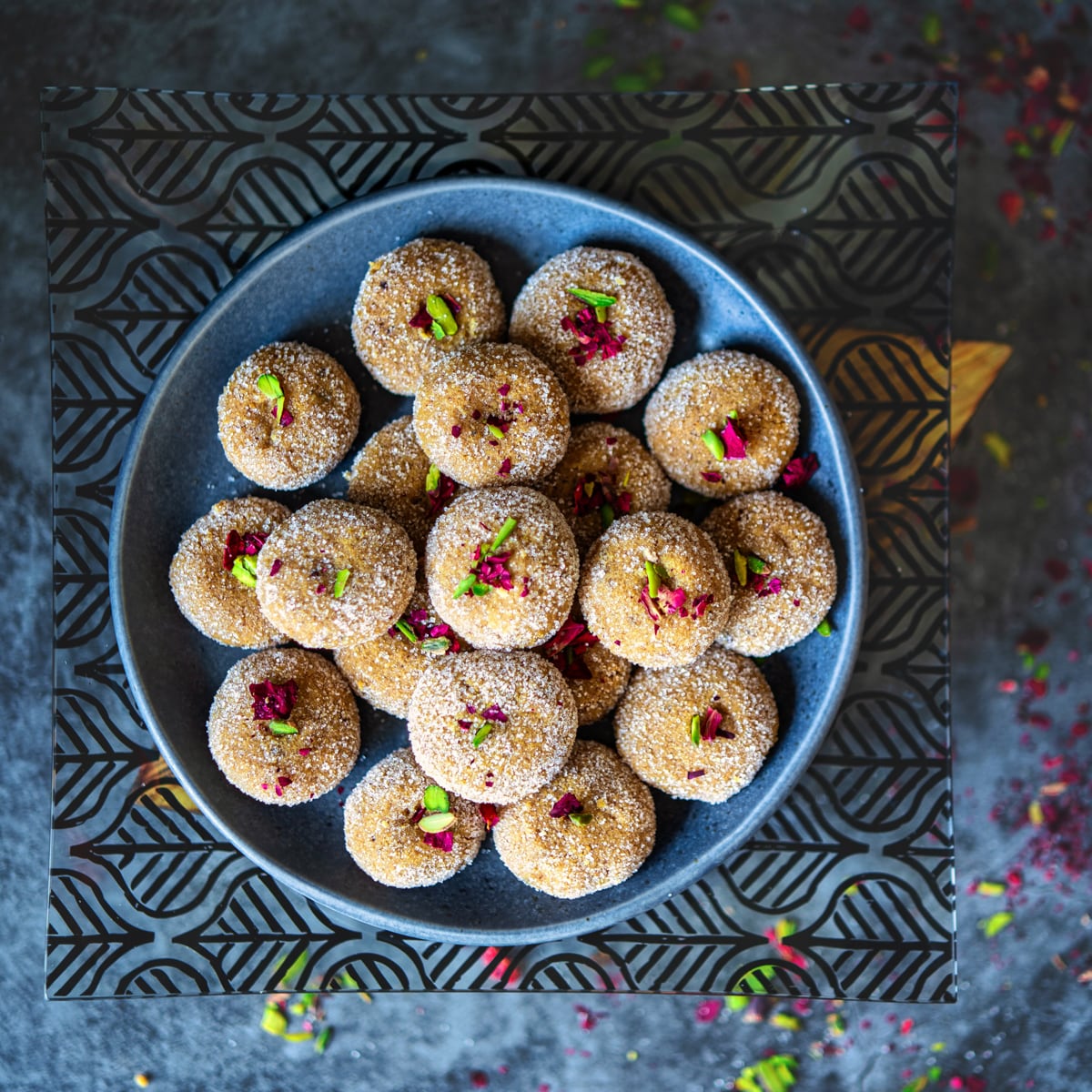
★★★★★
(Rating: 5 from 4 reviews)
| Prep time 🕐 | Cook time 🕐 | Total time 🕐 |
|---|---|---|
| 35 mins | ||
| Category ☶ | Cuisine ♨ | Serves ☺ |
| Desserts | Indian | 19-20 Pedas |
| Nutrition Info ⊛ | Serving size ⊚ | |
| 39 calories | 1 |
INGREDIENTS
For Mathura Peda
- 2 cups grated mawa (khoya)
- 1 1/2 tablespoons ghee
- 1/2 cup milk
- 1/2 teaspoon cardamom powder
- 1/2 cup granulated sugar/tagar/bura
- 1/2 cup granulated sugar/tagar/bura for rolling pedas
- Dried rose petals and pistachios for garnish (optional)
INSTRUCTIONS:
For making Mathura Peda
- Heat a non-stick pan or a heavy-bottomed pan over medium-low heat. Add the grated mawa (khoya) to the pan and roast it for about 5 minutes. After 5 minutes, add about 1 tablespoon of ghee and mix well to combine. Stir continuously on low heat to prevent the mawa from burning and sticking to the bottom of the pan. Cook for another 3-4 minutes until the mawa starts to turn light golden in color and releases a sweet aroma.
- While stirring, add 1/2 cup of milk gradually to the mawa. Continue to roast on low heat and stir until the milk is absorbed, and the mixture thickens. This should take around 3 minutes. When the milk is absorbed, add the remaining 1/2 tablespoon of ghee and mix again. Keep stirring and roasting the mawa at low heat for 3-4 minutes or until it turns deep caramel brown in color. Once the mixture looks perfectly roasted, turn off the heat. Add 1/2 teaspoon of cardamom powder to the mixture and mix well until combined. Let the mixture cool for a few minutes.
- Transfer this mixture onto a plate and spread it using a spatula. Add sugar/tagar/bura and mix with a spatula. When the mixture is warm but manageable to touch, knead it into a smooth dough using your hands. You can add 1-2 tablespoons of boiled and cooled milk if the mixture seems dry.
- Once the dough is ready, grease your hands with a little ghee and take small portions of the mixture to shape into pedas. Roll each portion into a smooth ball and then flatten it slightly to form a peda shape. Repeat the process until all peda mixture is used. I was able to get 19 small pedas out of this peda mixture. Place the 1/2 cup of sugar in a bowl/plate. Roll each peda in the sugar to coat it evenly. This sugar coating will give the pedas a sweet outer layer and a beautiful texture.
- Garnish each peda with dried rose petals and chopped pistachios for a traditional touch and added flavor. Let the pedas cool completely at room temperature. Once they cool, they will firm up. Your homemade Mathura pedas are ready to be enjoyed. Relish them immediately with friends and family, or store them in an airtight container at room temperature. They should stay fresh for a few days.
WATCH RECIPE VIDEO: Click the play button and video will load ...
NOTES:
- Mawa or Khoya is the heart and soul of this dessert, so make sure either you use fresh homemade mawa or use high-quality mawa (khoya) which is fresh and soft. Fresh mawa makes the best tasting creamy and smooth pedas. If for some reason your mawa is hard, then add 1 tablespoon of milk to the crumbled mawa and heat it in a microwave or a stove top pan to soften it before use.
- For making mawa desserts or other milk-based desserts it is recommended to use a thick bottomed pan or use a non-stick pan as they prevent sticking and burning.
- Perfect temperature: Always remember to roast the peda mixture over low to medium-low heat for even cooking. A slow cooking process ensures that you achieve the right color, consistency and prevents burning.
- To keep their freshness and prevent them from becoming dry, store these pedas in an airtight container or a parchment paper lined mithai box for up to 3-4 days at room temperature.
